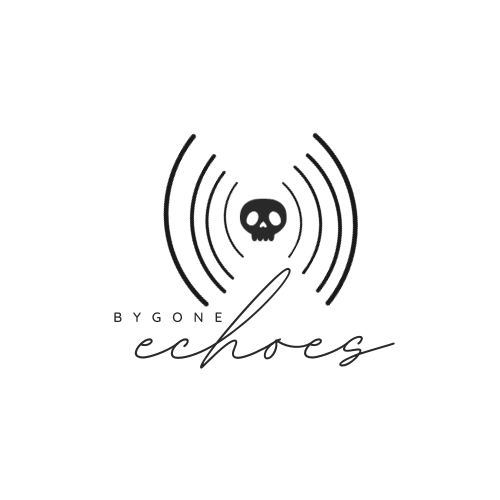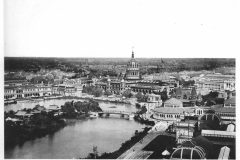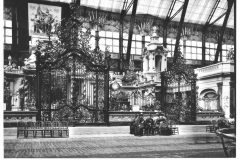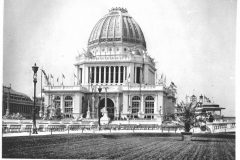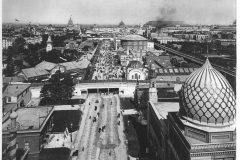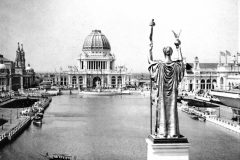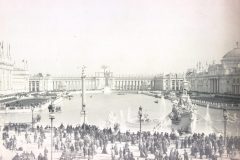The World’s Columbian Exposition – A (Not So) Exquisite Adventure
TL;DR: Yo, history buffs! The latest "Bygone Echoes" pod episode dives into 1893's Chicago World's Fair, a total Gilded Age mood with fancy tech and architecture (hello, first Ferris Wheel and Tesla's wild electricity). But, it wasn't all shiny: it had real dark vibes with major inequality, worker exploitation, and snubbing minorities. Plus, some seriously spooky stuff went down, like a kid's murder and the Chicago mayor getting assassinated. Next up in the pod? We're hitting up old-school trolley parks - think vintage amusement vibes. Stay tuned, history's never been this real. 🎡💡👻
Images courtesy of the Smithsonian Institute, Getty and Gutenberg.
Transcription
Trigger warning, this episode contains sensitive topics including child murder and suicide. Listener discretion is advised.
Hello friends, welcome to Bygone Echoes, a history podcast. I’m your host Courtney. I am so incredibly excited for our first episode ever. With that being said, let’s jump right in.
Today we travel back to 1893. The time filled with excitement and anticipation is when people from around the globe converge upon the vibrant city of Chicago, Illinois. The grand spectacle known as the Chicago World’s Fair, or the Columbian Exposition, loomed on the horizon embodying the very essence of the Gilded Age.
This era was marked by unprecedented progress, innovation, and dazzling achievements. But beneath the surface of this brilliant spectacle, a world of conflict and controversy simmered. The “White City”, as it was affectionately called, radiated with promises of a brighter future, but it couldn’t obscure the harsh realities and the widespread inequalities of the time. So join us on this adventure through history as we uncover the profound significance of this extraordinary event, where the marvels of innovation clash with the stark truths of the Gilded Age. Let’s travel all the way back to the world of 1893.
During this time, communication relied mainly on written correspondences and the buzzing sound of telegraph wires. In Britain, it was the Victorian era. Russia was reeling from a devastating famine that claimed half a million lives, leading to widespread criticism of the way the Tsar handled the situation1. And on a different note, Gandhi arrived in South Africa, where he stayed until 1914, leading nonviolent protests for Indian immigrants, and gaining valuable experience in civil rights activism.2
In the realm of fashion, affluent women favored hourglass-shaped silk and satin dresses adorned with lace and beadwork. Meanwhile, their male counterparts sported meticulously tailored three-piece suits, complete with high collars, top hats, and pocket watches. On the other hand, working-class women opted for practical high-neck dresses made from cotton and wool. And working-class men wore more functional shirts and vests than trousers, often crafted with rugged material like denim, and accessorized with suspenders and practical hats like the bowler hat.
In this era, they also witnessed a surge in the popularity of bicycles. Cycling was all the craze, leading to the creation of tailored cycling outfits for both men and women, signifying a shift in fashion and lifestyle because a lot of people questioned: should women even be riding bikes? 3
In terms of architecture, in the 1870s, there was a mix of eclectic styles, including Gothic, Italian, Torian, and early modernist influences.
When you take a look at the United States, the Gilded Age was actually coming to an end. This period was marked by stark social inequalities, political corruption, and labor unrest amid rapid industrialization and technological progress. Racial segregation and discrimination were pervasive, even in cities like Chicago. And women’s rights were very limited, they couldn’t even vote yet.
The influx of immigrants to the United States during this period faced stereotypes, discrimination, and even abuse due to their differences. Workers endured harsh and dangerous work conditions they had insane hours, and very low wages, I mean, the average laborer at that time only earned about $10 a week.4 All of this led to labor strikes and civil unrest.
The opulence of the Gilded Age was enjoyed by a privileged minority who lived in grand mansions and frequent exclusive social clubs, indulging in fine dining and hosting extravagant parties. This elite class wielded significant influence in both politics and business, which further cemented their privileged status in society.
In Chicago, about two decades before the Columbian Exposition, the city actually burned to the ground in what was known as “The Great Chicago Fire”. This tragedy resulted in the loss of hundreds of lives and millions of dollars and damages, and it left about one-third of the population of Chicago homeless.5 However, what followed was absolutely remarkable. With a rapid and impressive reconstruction, Chicago emerged from the ashes like a phoenix. By the time 1893 arrived, the population surged from just 300,000 in 1871 to over 1 million.
By the 1890s, Chicago had become a symbol of industrialization and urban expansion. The city attracted this diverse immigrant population who were often in search of economic opportunities. The landscape of Chicago was dominated by railroads, steel mills, and, most notably– slaughterhouses. The Union Stockyard, which was only located four miles south of downtown Chicago, served with the city’s meatpacking district. In 1890 alone, the city processed approximately 9 million animals.6 This significant activity earned Chicago the nickname of “the hog butcher of the world.” There is a poem written by Pulitzer Prize winner Carl Sandberg about the city of Chicago7 around this time.
The rapid industrial growth had dire consequences. Pollution from factories and poor sanitation practices contaminated the water supply, leading to widespread illnesses like typhoid fever and cholera.8 Poor living conditions in these crowded tenements also made it worse, highlighting the urgent need for improved sanitation and public health care in the rapidly growing city.
The selection of Chicago as the host city was a battleground of rivalries. The U.S. Congress had the final say in who would host. Cities like New York, St. Louis, Missouri and Washington D.C. fiercely competed with Chicago for this honor. Despite how quickly the city recovered from the fire, Chicago wrestled with crime, corruption, and poverty, and this starkly contrasted the grandeur envisioned for a world’s fair. People also did not think the “hog town” of Chicago could handle such a task, or even raise enough funds to host the event. World’s fairs are very expensive, and there’s never really a guarantee of ROI. So ultimately, the decision was marked by intense lobbying, political maneuvering, and allegations of underhanded tactics…but, that’s a story for another day.
The choice of Chicago as the host city for the exposition was influenced by several key things. Chicago’s central location in the United States and the status of the railroad hub made it easily accessible to visitors, ensuring a substantial revenue stream. The mayor of Chicago, Carter Harrison, Sr.9 was also crucial in securing the exhibition. He and other influential Chicago leaders actively lobbied Congress and made arguments in favor of Chicago. He also had visionary leaders like Daniel Burnham and Frederick Law Olmsted, both of whom I totally adore, who were pivotal in conceptualizing and designing the fair. They decided to center the fair’s theme around Christopher Columbus10 and his arrival in the Americas, which was a narrative that deeply resonated with the people in power at the time.
Daniel Burnham11 was a prominent American architect and urban planner who led the Chicago World’s Fair design. Burnham supported the City Beautiful movement, and his influence led to urban planning reforms that we still see in U.S. cities today. Despite lacking any formal architectural education, Burnham played a vital role in the design and leadership of the Colombian exposition.
Frederick Law Olmsted12 was a renowned American landscape architect known for designing iconic public parks like Central Park in New York City13. He emphasized natural beauty and accessibility. His work also had a lasting impact on urban planning and landscape architecture and the United States, and it was Olmsted’s firm that was hired to work on the landscaping and overall aesthetic of the fair grounds, which was truly a feat in itself.
The economic powerhouse and recovery from the great Chicago fire demonstrated the city’s suitability as a showcase for American progress, and the architects and planners dreamt of building a town for the fair that symbolized hope and innovation, the “White City”. However, despite winning the bid, Chicago faced skepticism and immense challenges. I mean, there were even Chicagoans who didn’t think they could do it.

The team had about two years to pull off a large-scale international event. They had to navigate the demands and preferences of influential funders, politicians and other key figures, which is a very challenging task to get a unanimous agreement on anything. There were also ongoing labor disputes. Who’s going to do the work? And then there was the need to address public health concerns because Typhoid Fever was an epidemic at this time. They also had to develop architectural innovations and ingenuity in order to pull this off on time and within budget.
And, to top it all off, the organizers wanted this moment to be unique. They wanted Chicago to shine and to create a spectacular engineering feat, something that would rival other international exhibitions, like the 1899 Paris Exposition where the Eiffel Tower was unveiled to the world.
Burnham led the crusade. He was known for his dictum, “Make No Little Plans”, but he faced enormous challenges. He and Olmstead had to transform this marshy, muddy, ick area of Chicago, known as Jackson Park14, into the White City, a task both daunting and riddled with difficulties.
Their methods were often questioned, and the labor conditions for the workers were harsh and unrealistic. On top of all that, you have the… interesting weather15, in Chicago and the seasonal changes that they had to work through in order to meet this deadline.
Despite the overwhelming challenges, they technically kicked off the fair on the scheduled date. It was scheduled to run six months. That’s it. Six months. Ticket to the fair cost 50 cents, 25 cents for children under 12, and admission was free for children under six.
Chicago celebrated the Grand Exhibition’s opening with immense joy. This was truly a testament to their hard work, their dedication. Look at them showing the world how amazing they are! But then something very chilling occurred during the fair’s opening week. Seven-year-old Emma Werner16 vanished while playing outside in her Chicago neighborhood, sparking a frantic search by her German immigrant family. Unfortunately, Emma’s lifeless body was found the following day. George Craig, a 21-year-old painter employed at the World’s Fair, confessed to the crime and was eventually found guilty. Craig, who had been very busy at this time, also trying to lure other girls and young women away during this time. He was eventually found guilty, receiving 30 years, which definitely surprised him. He thought for sure he was getting life in prison or execution. Controversially, his incarceration was shortened less than five years later. Why? Well, he had contracted consumption, also known as tuberculosis, and was granted his freedom to die at home surrounded by his friends and family.
The Panic of 189317 coincided with the fair’s opening, driven by railroad failures, drought, gold shortages, and a decline in foreign investments. This, unfortunately, caused a huge economic depression with bank failures declining industry and high unemployment. How much unemployment? We don’t actually know. Government agencies didn’t reliably track this information back then, and there were also no aid or welfare programs. If your bank failed, you lost everything. This led to stress, depression, and sometimes even suicide. Not even the children were spared. There’s a story I read about a school that recently started a savings program in conjunction with their local bank. Unfortunately, that bank failed and the children lost all of their savings.
Furthermore, the exposition was not immune to the societal prejudices of the time. The White City mirrored racial segregation and discrimination prevalent then. African Americans and other minorities found themselves largely excluded from the narrative of progress and innovation that the fair claimed to present. This sparked significant protests and debates, which further contributed to the exposition’s controversial nature.
The Colombian exposition’s layout revolved around the White City, a grand neoclassical masterpiece spanning 600 acres in Chicago’s Jackson Park. Over 200 structures were constructed for this event, and most of them were designed to be temporary. This event also spearheaded advancements in sanitation and public health practices, increasing awareness and also setting the standard for improved sanitation in public spaces.
The architectural marvels featured a Court of Honor with a reflecting pool, showcasing various exhibits. The Midway Plaisance added entertainment while pavilions represented different countries and states. Every structure was built of gleaming white staff material, which the organizers felt helped symbolize purity and progress, intentionally contrasting the era’s polluted industrial cities. This deliberate design created an enduring and symbolic architectural landscape that deeply impacted the visitors, embodying the fair’s innovation and cultural richness.
The centerpiece of the fair, the Administration Building, was a marvel of neoclassical architecture. It featured a dramatic dome, an intricate facade that drew inspiration from the grandeur seen in the European cathedrals.
The Machinery Hall18 was a remarkable feat of engineering, resembling a cathedral dedicated to industry. It was an immense, ironclad structure housing cutting-edge machinery, and technological wonders like steam engines and electricity.
The Palace of Fine Arts was a grand Beaux-Arts masterpiece with a massive dome, columns, sculptures, and a reflecting pool. The palace featured works from artists such as Claude Monet. Unlike the other structures of the fair, the palace was built using permanent material because it was intended to be a lasting legacy of the 1893 Columbian Exposition. The organizers wanted the Palace of Fine Arts to be enduring as a cultural institution in Chicago after the fair ended.
The Court of Honor, amidst all of these colossal structures, was serene yet somber, with tranquil water mirroring these ethereal buildings. As night fell, the emergence of electric lights cast an eerie shadow upon the water’s surface, transforming the scene into a hauntingly beautiful spectacle leaving visitors in awe.
The exact smells experienced by attendees would have varied throughout the fairgrounds. Olmsted’s team designed landscapes with beautiful blooming flowers and lush greenery. It was very visually and aromatically captivating. Visitors might also experience the aromas of the diverse cultural foods being prepared. There’s also the scent of the animals and agricultural exhibits and the industrial odors emanating from the machinery and technology displays.
The fair featured iconic American snacks like popcorn, hamburgers, and hot dogs. The fair also incorporated diverse ethnically inspired cuisine from Mexican, German, Chinese, and other cultures. Visitors could enjoy exotic fruits like pineapples and bananas, considered novelties back then, and various beverages like soft drinks and root beer. Clean water was provided through an innovative filtration and distribution system, which practically eliminated the fears of waterborne illnesses. 19
Visitors would have heard the bustling chatter of crowds, the clinking of dishes and food stalls, the music and performances at various pavilions and stages, the mechanical hum of new inventions and machinery, and the occasional announcement or speech going on. Some of the popular songs were still familiar with today’s debut at the fair, including The Liberty Bell by John Philip Sousa, which was later used as the Monty Python theme, and Stars and Stripes Forever, also by Sousa (which is a song that I’ve only heard in the Fallout 3 game, but also still a song).
The Midway Plaisance was an entertainment area with diverse attractions, including skill games, rides, cultural exhibits, international food and entertainment, novelty attractions, shopping, and souvenirs. This is also where we get the term Midway from, used in fairs and carnivals still today.
The Columbian Exposition featured an insane amount of awe-inspiring wonders, including the debut of the groundbreaking Ferris Wheel. The Ferris Wheel was the colossal engineering feat that the fair organizers envisioned, something that they felt would compete with the grandeur of the Eiffel Tower. And you’ve probably seen one as of today, so it still totally exists today. Conceptualized, designed, built and funded through the efforts of its creator, George Ferris, it both amazed and unsettled people. Its enormous size, elevated guests above the ground, providing an almost supernatural perspective of the White City. It was a unique blend of, wow, this is so cool, and oh my goodness, please get me down!
The visitors also encountered cutting-edge technology at the Exposition, like Nikola Tesla’s groundbreaking alternating current, also known as AC. Up until this point in history, gas lamps reigned supreme. Tesla’s AC power, which illuminated the fairgrounds and various exhibits, was revolutionary. But people were also afraid of it because it was unfamiliar, and there were also rumors of it’s danger.
At the Exposition, visitors also encountered unique exhibits like the Libby Glassworks. This captivating spectacle involved artists in shaping molten glass into intricate art pieces before a fascinating audience. It seemed almost alchemical in nature.
While the fair celebrated technological and cultural advancements, it also revealed a shadow of exclusion. The White City largely overlooked the contributions of African Americans and other minorities, which mirrored the social prejudices of the Gilded Age. The fair itself marked almost 30 years since the abolition of slavery in the United States. In that time, African Americans achieved progress through civil rights, education, literature, journalism, business, politics. They were doing so many amazing things. And you had pioneers like Frederick Douglass and Ida B. Wells20 playing vital roles. This omission of African Americans and their culture ignited significant protests. And people passionately campaigned against this exclusion and discrimination.
The portrayal of black people and other minorities at the fair differed significantly from their white counterparts. Unlike exhibits celebrating diverse cultures, the African villages at the fair had a distinct and troubling agenda, as Frederick Douglas pointed out: they wanted to depict African Americans as repulsive savages.
Although African Americans and other minorities were not prohibited from attending the fair, they were not welcomed either. As a cruel joke, the fair organizers held a Colored People’s Day, offering watermelons as a derogatory gesture to the African American fairgoers21. This exclusion and the unequal treatment tarnished the vision of progress that the fair tried to showcase.
The 1893 Columbian Exposition also promoted imperialism and colonial ideologies with exhibits that indirectly supported European superiority and it aligned with prevalent colonial beliefs at that time. One specific example was a portrayal of indigenous peoples as exotic or inferior, which perpetuated stereotypes.22 These exhibits helped reinforce distorted views of indigenous communities. And it contributed to the cultural narrative justifying colonialism in that era. 23
The labor practices at the fair were, simply put, exploitative. Many workers, often immigrants, endured grueling work conditions, and they received minimal wages.24 This was a stark contrast between the exploitation of laborers and the luxury displayed within the fair, highlighting the inequalities of this time.
And so while this event is remembered for its architectural and technological marvels, it also reflected the cultural shadows, the issues of racism, imperialism, and labor exploitation that lingered beneath the surface.
The Columbian Exposition attracted over 27 million visitors during its six-month run, from May 1st to October 30th, 1893. That’s over 40% of the country’s population at that time! Which is like a super rough estimate. A very glorified guesstimate! But anyway, in terms of revenue, the fair generated approximately $28.2 million in income. But it also incurred significant expenses, including organizing the fairgrounds and building everything, which totaled around $27.3 million. So the net profit was not at all what the organizers had in mind.
As we conclude our journey through the 1893 Columbian Exposition, you may be surprised to learn that the fair began and ended with a murder. Chicago Mayor Carter Harrison Sr, that popular figure mentioned earlier who got the fair to Chicago, was assassinated days before the fair ended. He was shot and killed by what we will call a disgruntled job seeker.25 Harrison’s assassination was tragic and it was unexpected, and it really cast a shadow over the event and the way that it ended. There were also the crimes of another murderer, H.H. Holmes, as you may or may not know, which did not come to light until years after the fair ended.
The economic depression, which coincided with the start of the fair, persisted for years and it triggered political shifts and reforms. It laid the groundwork for the rise of new political movements and it emphasized economic and social change, which ultimately ushered in the Progressive Era26 in the United States.
After the fair ended, many of the buildings were demolished. A few structures were moved or repurposed. In July of 1894, whatever remained of the fair was destroyed by a fire.27 The Midway Plaisance remains a park today, as does Jackson Park, in Chicago. The Museum of Science and Industry now occupies the former Palace of Fine Arts in Jackson Park, one of the few remaining fair buildings and it is a lasting legacy of the event. The engineering marvel that is the Ferris wheel was disassembled after the fair and then used at other events until it was finally scrapped in 1906. 28
The fair left a mark on American culture, its architectural grandeur and technological innovations really shaped the future for future expositions held in other countries, in America, and impacted urban design. 29
The famed Chicago architect, Louis Sullivan, was said to have complained that the exposition’s grand neoclassical building design set American architecture back by 50 years.30 The innovative use of electricity set a standard for the world. The fairgrounds also introduced novelties like Cracker Jack Popcorn and Wrigley’s chewing gum. And, apparently the zipper (like for your clothing) and the dishwashing machine which, go figure.
Yet the fair’s legacy is also haunted by the shadow it casts. The societal inequalities it mirrored, the lost lives or the lives who were forever changed by its creation, and it also illuminated the darker aspects of human ambition.
The White City, for all of its brilliance, also symbolized the complexities and contradictions of the Gilded Age. It’s inspiring and it has a haunting legacy that continues to captivate and intrigue to this day.
Thanks for joining us on this exploration of the 1893 Colombian World Exhibition. We journeyed to the Gilded Age in the vibrant city of Chicago where we toured the grand halls and landscape of the World’s Chicago Exhibition. Along the way, we delved into its shadowy corners uncovering stories that intrigue and invite reflection on this forgotten piece of history.
Next time on Bygone Echoes, we embark on a journey to explore the enchanting world of…. trolley parks! Placed along streetcar lines, these historic amusement destinations were the epicenters of fun and leisure in the late 19th and 20th centuries. Join us as we uncover these trolley park gems forgotten stories thrilling rides in vibrant culture. Stay tuned for a ride back in time on the next episode of Bygone Echoes.
Interested in learning more? We recommend:
- Devil in the White City by Erik Larson
- Murder During the Chicago World’s Fair: The Killing of Little Emma Werner by R. Barri Flowers
- The World’s Columbian Exposition by Christine Liang and Norm Bolotin
- The poem, Chicago, by Carl Sandburg
Citations
- York, Carnegie Corporation of New. “U.S.-Russia Relations: Quest for Stability.” Usrussiarelations.org, usrussiarelations.org/2/timeline/first-contact/46#:~:text=The%20Russian%20famine%20of%201891. ↩︎
- “Mohandas Karamchand Gandhi.” South African History Online, 18 Mar. 2019, www.sahistory.org.za/people/mohandas-karamchand-gandhi. ↩︎
- Metcalf, Meg. “Research Guides: Bicycles and Cycling History: A Resource Guide: Women and Bicycles.” Guides.loc.gov, guides.loc.gov/bicycles-cycling-history/subject/women. Accessed 27 Dec. 2023. ↩︎
- Concannon, Marie. “Library Guides: Prices and Wages by Decade: 1890-1899.” Libraryguides.missouri.edu, libraryguides.missouri.edu/pricesandwages/1890-1899. ↩︎
- “The Great Chicago Fire of 1871.” Chicago Architecture Center – CAC, www.architecture.org/learn/resources/architecture-dictionary/entry/the-great-chicago-fire-of-1871/. ↩︎
- “Stockyards, the Union – WTTW.” Interactive.wttw.com, interactive.wttw.com/a/chicago-stories-union-stockyards. ↩︎
- Poetry Foundation. “Poetry Magazine.” Poetry Foundation, 2010, www.poetryfoundation.org/poetrymagazine/poems/12840/chicago. ↩︎
- “Epidemics.” Www.encyclopedia.chicagohistory.org, www.encyclopedia.chicagohistory.org/pages/432.html. ↩︎
- “Carter Harrison (1825-1893) | American Experience | PBS.” Www.pbs.org, www.pbs.org/wgbh/americanexperience/features/chicago-carter-harrison-1825-1893/. ↩︎
- “World’s Columbian Exposition of 1893 | American Experience | PBS.” Pbs.org, 2019, www.pbs.org/wgbh/americanexperience/features/chicago-worlds-columbian-exposition-1893/. ↩︎
- “About Daniel Burnham.” Www.chipublib.org, www.chipublib.org/about-daniel-burnham/. ↩︎
- “Parks for the People: Frederick Law Olmsted and the Evolution of the Olmsted Firm, 1822-1900 | Timelines | Articles and Essays | Olmsted Associates Records | Digital Collections | Library of Congress.” Library of Congress, Washington, D.C. 20540 USA, www.loc.gov/collections/olmsted-associates-records/articles-and-essays/timelines/evolution-of-olmsted-firm-1822-to-1900/. ↩︎
- “Olmsted–Designed Parks : NYC Parks.” Nycgovparks.org, 2019, www.nycgovparks.org/about/history/olmsted-parks. ↩︎
- “What Is Landscape Architecture?” Www.architecture.org, www.architecture.org/news/happening-caf/what-is-landscape-architecture/. Accessed 27 Dec. 2023. ↩︎
- “Climate of Chicago.” Wikipedia, 22 Nov. 2022, en.wikipedia.org/wiki/Climate_of_Chicago. ↩︎
- R. Barri Flowers. Murder during the Chicago World’s Fair: The Killing of Little Emma Werner (a Historical True Crime Short). R. Barri Flowers, 17 Mar. 2017. ↩︎
- “Banking Panics of the Gilded Age | Federal Reserve History.” Www.federalreservehistory.org, www.federalreservehistory.org/essays/banking-panics-of-the-gilded-age#:~:text=The%20Panic%20of%201893%20was. ↩︎
- “Machinery Hall Archives.” Chicagos 1893 Worlds Fair, worldsfairchicago1893.com/tag/machinery-hall/. ↩︎
- ““Bureau of Public Comfort,” Official Directory of the World’s Columbian Exposition, 1893.” Chicagohistory.org, 2020, www.encyclopedia.chicagohistory.org/pages/10905.html. ↩︎
- “Ida B. Wells: African Americans at the World’s Columbian Exposition.” Www.encyclopedia.chicagohistory.org, www.encyclopedia.chicagohistory.org/pages/1495.html. ↩︎
- “Watermelon Stereotype.” Wikipedia, 22 Dec. 2023, en.wikipedia.org/wiki/Watermelon_stereotype#:~:text=The%201893%20World. Accessed 27 Dec. 2023. ↩︎
- “Early Chicago: The 1893 World’s Fair.” WTTW Chicago, 6 July 2018, interactive.wttw.com/dusable-to-obama/1893-worlds-fair. ↩︎
- Beck, David R. M. “Fair Representation? American Indians and the 1893 Chicago World’s Columbian Exposition.” World History Connected, vol. 13, no. 3, 1 Oct. 2016, worldhistoryconnected.press.uillinois.edu/13.3/forum_01_beck.html. ↩︎
- Scott. “Pushing for a Labor Strike at the Fair.” Chicago’s 1893 Worlds Fair, 3 Sept. 2018, worldsfairchicago1893.com/2018/09/03/labor-strike/. Accessed 27 Dec. 2023. ↩︎
- “Patrick Eugene Prendergast.” Wikipedia, 15 Dec. 2023, en.wikipedia.org/wiki/Patrick_Eugene_Prendergast#:~:text=Patrick%20Eugene%20Joseph%20Prendergast%20(6. Accessed 27 Dec. 2023. ↩︎
- Klein, Christopher. “How Gilded Age Corruption Led to the Progressive Era.” HISTORY, 4 Feb. 2021, www.history.com/news/gilded-age-progressive-era-reforms. ↩︎
- “1894 Fair Fires.” Chicagology.com, chicagology.com/columbiaexpo/fairfire/. ↩︎
- Dumlija, Marko. “Chicago’s Ferris Wheel Story.” Chicago Architecture Center – CAC, www.architecture.org/news/evolving-chicago/chicagos-ferris-wheel-story/. ↩︎
- Wolski, Tamara . The World’s Columbian Exposition’s Lasting Effect on Chicago . https://www.eiu.edu/historia/2010Wolski.pdf, 2009. ↩︎
- “Daniel Hudson Burnham | Encyclopedia.com.” Www.encyclopedia.com, www.encyclopedia.com/people/literature-and-arts/architecture-biographies/daniel-hudson-burnham#:~:text=Famed%20Chicago%20architect%20Louis%20Sullivan. Accessed 27 Dec. 2023. ↩︎
